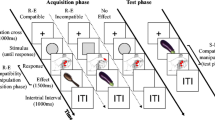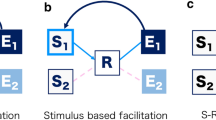Abstract
Recent studies reported converging evidence for action–effect associations if participants adopted an intention-based action control mode in free choice conditions, whereas no evidence for action–effect associations was found when participants adopted a stimulus-based mode in forced choice conditions. However, it is not yet clear whether action control modes moderate acquisition or usage of action–effect associations. In the present experiment, two groups of participants underwent an acquisition phase consisting of either free or forced choice key presses that produced irrelevant, but contingent effect tones. In a subsequent test phase, participants freely chose the key to press after former effect tones were presented. A reliable consistency effect resulted for both the groups, i.e. participants preferred the key that produced the irrelevant tone in the preceding acquisition phase. In combination with prior findings, this consistency effect suggests that usage, but not acquisition of action–effect associations depends on an intention-based action control mode.


Similar content being viewed by others
Notes
Prior implementations of the current experimental design used two independent criteria for participant selection (Elsner & Hommel, 2001, Exp. 3B; Hoffmann et al., 2009, Exp. 2). As first selection criterion, more than 10% erroneous responses in nogo-trials were considered as an indicator of response selection prior to go-signal onset. This behaviour would lead to reduced consistency effects as a prepared response is unlikely to be affected by tones accompanying the go-signal. This tendency was not present in the current data-set (r = 0.12 between the percentage of consistent choices and the number of nogo-errors). As second selection criterion, relative percentages of left and right reactions were compared and participants were excluded from data analysis when the distribution was not considered as even. This procedure is statistically warranted as an uneven distribution of response choices inevitably reduces the chance of finding a consistency effect that might be present in the data. This trend was also present in the current data, indicated by a correlation of r = −0.15 between the relative percentage of consistent key presses and the percentage of the preferred response. However, to obtain a conservative estimate of the consistency effect, we did not exclude any participant in the present study.
References
Ach, N. (1935). Analyse des Willens [Analysis of the Will]. Berlin: Urban & Schwarzenberg.
Dutzi, I. B., & Hommel, B. (2009). The microgenesis of action–effect binding. Psychological Research, 73, 425–435.
Elsner, B., & Hommel, B. (2001). Effect anticipation and action control. Journal of Experimental Psychology: Human Perception and Performance, 27, 229–240.
Greenwald, A. G. (1970). A choice reaction time test of ideomotor theory. Journal of Experimental Psychology, 86, 20–25.
Herbart, J. F. (1825). Psychologie als Wissenschaft neu gegründet auf Erfahrung, Metaphysik und Mathematik [Psychology as a science newly founded on experience, metaphysics, and mathematics]. Königsberg: August Wilhelm Unzer.
Herwig, A., Prinz, W., & Waszak, F. (2007). Two modes of sensorimotor integration in intention-based and stimulus-based actions. Quarterly Journal of Experimental Psychology, 60, 1540–1554.
Herwig, A., & Waszak, F. (2009). Intention and attention in ideomotor learning. Quarterly Journal of Experimental Psychology, 62, 219–227.
Hoffmann, J., Berner, M., Butz, M. V., Herbort, O., Kiesel, A., Kunde, W., et al. (2007). Explorations of anticipatory behavioral control (ABC): A report from the cognitive psychology unit of the University of Würzburg. Cognitive Processing, 8, 133–142.
Hoffmann, J., Lenhard, A., Sebald, A., & Pfister, R. (2009). Movements or targets: What makes an action in action effect learning? Quarterly Journal of Experimental Psychology, 62, 2433–2449.
Hoffmann, J., Sebald, A., & Stöcker, C. (2001). Irrelevant response effects improve serial learning in serial reaction time tasks. Journal of Experimental Psychology: Learning, Memory, and Cognition, 27, 470–482.
Hommel, B. (1993). Inverting the Simon effect by intention. Psychological Research, 55, 270–279.
Hommel, B. (1996). The cognitive representation of action: Automatic integration of perceived action effects. Psychological Research, 59, 176–186.
Hommel, B., Alonso, D., & Fuentes, L. J. (2003). Acquisition and generalization of action effects. Visual Cognition, 10, 965–986.
Keller, P. E., Wascher, E., Prinz, W., Waszak, F., Koch, I., & Rosenbaum, D. A. (2006). Differences between intention-based and stimulus-based actions. Journal of Psychophysiology, 20, 9–20.
Kiesel, A., & Hoffmann, J. (2004). Variable action effects: Response control by context-specific effect anticipations. Psychological Research, 68, 155–162.
Kühn, S., Elsner, B., Prinz, W., & Brass, M. (2009). Busy doing nothing: Evidence for non action–effect binding. Psychonomic Bulletin & Review, 16, 542–549.
Kunde, W. (2001). Response–effect compatibility in manual choice reaction tasks. Journal of Experimental Psychology: Human Perception and Performance, 27, 387–394.
Kunde, W. (2003). Temporal response–effect compatibility. Psychological Research, 67, 153–159.
Kunde, W., Elsner, K., & Kiesel, A. (2007). No anticipation-no action: The role of anticipation in action and perception. Cognitive Processing, 8, 71–78.
Kunde, W., Koch, I., & Hoffmann, J. (2004). Anticipated action effects affect the selection, initiation and execution of actions. Quarterly Journal of Experimental Psychology. Section A: Human Experimental Psychology, 57A, 87–106.
Maes, J. H. (2006). Response bias induces in rats by response effects. Quarterly Journal of Experimental Psychology, 59, 1346–1356.
Prinz, W. (1998). Die Reaktion als Willenshandlung. Psychologische Rundschau, 49, 10–20.
Stock, A., & Hoffmann, J. (2002). Intentional fixation of behavioural learning, or how R–O learning blocks S–R learning. European Journal of Cognitive Psychology, 14, 127–153.
Wenke, D., Waszak, F., & Haggard, P. (2009). Action selection and action awareness. Psychological Research, 73, 602–612.
Ziessler, M. (1998). Response–effect learning as a major component of implicit serial learning. Journal of Experimental Psychology: Learning, Memory, and Cognition, 24, 962–978.
Author information
Authors and Affiliations
Corresponding author
Rights and permissions
About this article
Cite this article
Pfister, R., Kiesel, A. & Hoffmann, J. Learning at any rate: action–effect learning for stimulus-based actions. Psychological Research 75, 61–65 (2011). https://doi.org/10.1007/s00426-010-0288-1
Received:
Accepted:
Published:
Issue Date:
DOI: https://doi.org/10.1007/s00426-010-0288-1




